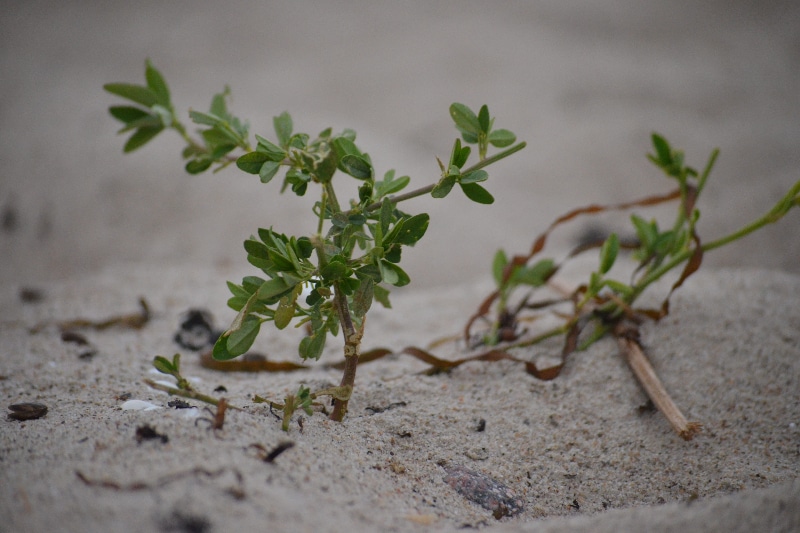You have three steps to undergo to learn how to sterilize sand for plants. Remember that sand is one of the most popular media for growing plants because it improves aeration for optimal root health and development. It’s not enough to start plants in an ideal environment, but the medium also plays a significant role.
Sand is not only a useful medium in terms of plant health and growth, but it is also relatively affordable and easy to find. However, it’s not enough to directly use sand without sterilizing it or risk introducing pests or diseases in the garden. Below are three steps to ensure that the sand you use will only offer you advantages.

How To Sterilize Sand For Growing Plants
Step #1. Preparation
The first step to get your sand ready for the garden or container plants is preparing everything you need to sterilize it. Since you’ll be using the oven for this method, you can preheat it at 180°F to make the process quicker later on. It would help if you also washed the sand as an initial clean-up.
The easiest way to do this is by placing the sand in a bucket and submerge it in the water while simultaneously stirring it. This way, you can ensure that you are cleaning the sand thoroughly before the second step. Continue washing the sand until you end up with clear water, and then you can pour this water out before the second step.
Step #2. Submersion
After cleaning the sand, you will do a second rinsing or submersion with hot water. Use boiling hot water and pour it into the bucket to submerge all the sand. Let the submersion sit for some time before pouring out the water and then repeating the process about three times.
After cleaning the sand with hot water for as much as needed, you must run the sand once more with water. It may seem like so much work, but you’re aiming to have clean sand indicated by clear and clean water after washing. Only after then that you can pour as much water out of the sand.
Step #3. Drying
You’ll be left with damp sand after the first two steps. To dry it, use a towel until there’s no moisture left. Place the dried sand on a baking sheet for the final stage of sterilization, but it’s worth noting to spread it thinly to ensure good results.
Place the sand inside the oven and bake it for half an hour; after all, baking is a tried and tested sterilization method. The heat should kill any residual pathogens or microorganisms that are left after you washed it. Afterward, check if there are any moist sand and adjust the baking time if necessary.
Why Use Sand For Plants?
The quick answer to this is that sand is an inexpensive way to improve the medium’s porosity. It is easy to find, cheap, and sometimes a free solution to help create a well-draining soil. Remember that poor-draining soil puts the plants at risk in standing water that is detrimental to their health and growth.
It’s best to use horticultural sand, but you can also substitute it with builders’ sand. Aim to have gritty sand to ensure that it’ll be useful for improving the soil structure. However, remember to sterilize it first to ensure that it is free of pathogens that can cause diseases to the plants.
How To Use Sand For Plants
It’s common to mix sand with compost to create a well-draining soil-free medium for starting seeds and cuttings. This is excellent in addition to growing in the greenhouse to ensure quicker root development. The combination of a well-draining substrate and stable environment is best for propagating plants.
The mix of sand and peat is also better for container growing because the soil is too compact. You don’t want to suffocate your plant roots by using soil, so gauge the appropriate ratio according to your plant needs. You can also use sand on top of the potting mix or add sand in clay to improve its porosity.
Lastly, some gardeners rake sand into the lawn to prevent it from becoming waterlogged. This way, you’ll achieve healthier lawn grass without the need to do any amendments. You can also create holes in the area to make the improvement easier.
Conclusion
If you have some sand that you want to use in the garden or container plants in the greenhouse, there’s a crucial step that you must do. You must know how to sterilize sand for plants properly to ensure that you’re not exposing them to pathogens and microorganisms that can cause diseases. You only need three steps to do so with the help of regular household items.
Start by washing your sand via submersion in a bucket with water, and stir the mix around until the water is no longer dark. Then, boil some water and use this for a similar process. After using hot water, submerge your sand again until the water is clear.
Towel dry the sand and place it in the oven for half an hour. You should end up without any moist sand that is safe to use for plants. Properly sterilized sand offers many benefits to your plants, including improving the soil structure, so never overlook these three steps.
